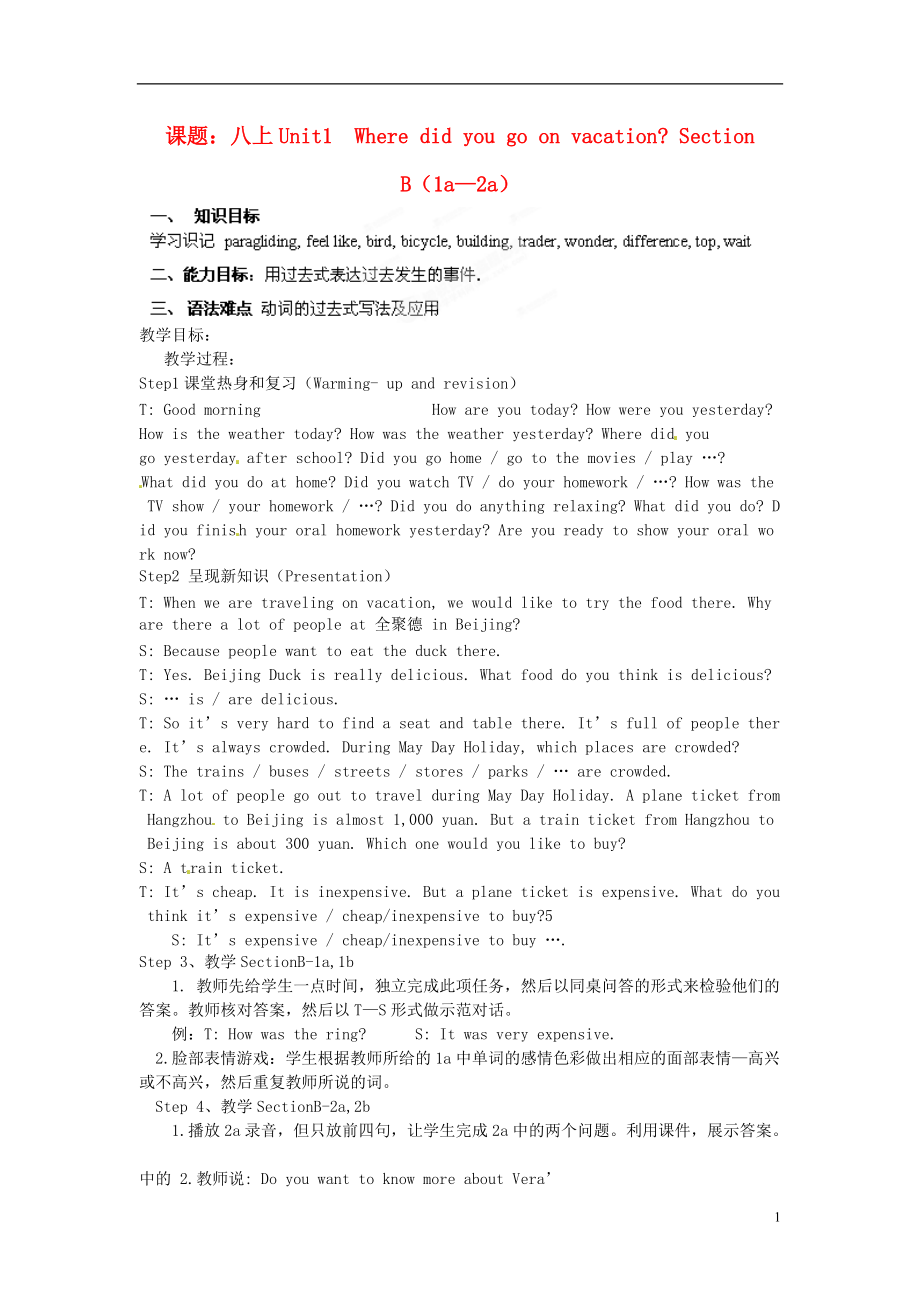《八年級英語上冊《Unit 1 Where did you go on vacation Section B(1a2a)》教學案 (新版)人教新目標版》由會員分享,可在線閱讀�,更多相關(guān)《八年級英語上冊《Unit 1 Where did you go on vacation Section B(1a2a)》教學案 (新版)人教新目標版(2頁珍藏版)》請在裝配圖網(wǎng)上搜索。
1�����、
課題:八上Unit1 Where did you go on vacation? Section B(1a—2a)
教學目標:
教學過程:
Step1課堂熱身和復習(Warming-upandrevision)
T:Goodmorning Howareyoutoday?Howwereyouyesterday? Howistheweathertoday?Howwastheweatheryesterday?Wheredidyou
goyesterdayafterschool?Didyougohome/gotothemovies/play…? Whatdidyoudoathome?
2���、DidyouwatchTV/doyourhomework/…?HowwastheTVshow/yourhomework/…?Didyoudoanythingrelaxing?Whatdidyoudo?Didyoufinishyouroralhomeworkyesterday?Areyoureadytoshowyouroralworknow?
Step2 呈現(xiàn)新知識(Presentation)
T:Whenwearetravelingonvacation,wewouldliketotrythefoodthere.Whyaretherealotofpeopleat全聚德inBeijing?
3�、S:Becausepeoplewanttoeattheduckthere.
T:Yes.BeijingDuckisreallydelicious.Whatfooddoyouthinkisdelicious?
S:…is/aredelicious.
T:Soit’sveryhardtofindaseatandtablethere.It’sfullofpeoplethere.It’salwayscrowded.DuringMayDayHoliday,whichplacesarecrowded?
S:Thetrains/buses/streets/stores/parks/…arecrowd
4����、ed.
T:AlotofpeoplegoouttotravelduringMayDayHoliday.AplaneticketfromHangzhoutoBeijingisalmost1,000yuan.ButatrainticketfromHangzhoutoBeijingisabout300yuan.Whichonewouldyouliketobuy? S:Atrainticket.
T:It’scheap.Itisinexpensive.Butaplaneticketisexpensive.Whatdoyouthinkit’sexpensive/cheap/inexpensivet
5、obuy?5
S:It’sexpensive/cheap/inexpensivetobuy….
Step 3���、教學SectionB-1a,1b
1.教師先給學生一點時間���,獨立完成此項任務(wù),然后以同桌問答的形式來檢驗他們的答案�����。教師核對答案,然后以T—S形式做示范對話�����。
例:T:Howwasthering? S:Itwasveryexpensive.
2.臉部表情游戲:學生根據(jù)教師所給的1a中單詞的感情色彩做出相應(yīng)的面部表情—高興或不高興��,然后重復教師所說的詞���。
Step 4、教學SectionB-2a,2b
1.播放2a錄音���,但只放前四句���,讓學生完成2a中
6、的兩個問題��。利用課件���,展示答案�。
中的2.教師說:DoyouwanttoknowmoreaboutVera’svacationinTokyo?Listentotherestofthedialogueandtrytofindoutthewordsforthegoodthings,andwordsforthebadthingsinthedialogue.GroupA,findoutthewordsforJ.GroupB,findoutthewordsforL.
T:Foryourwonderfuljob,IwillshowyouafacelikethisJ.
?�。ɡ蠋熥饕粋€微笑的表情,
7��、表示對學生鼓勵�����。)
T:Butwhatwasinteresting/expensive/crowded?Nowlet’slistentothetapeagainandfinish2b.(完整地播放2a錄音���。)
T:Nowlet’schecktheanswers.
(學生用完整的句子表述答案�����。例如:Hervacationwasgreat.TheJapanesepeoplewerefriendly.…)
教師利用課件����,給出參考答案��。
Step 5���、教學SectionB-2c
教師要求同桌編對話��,談?wù)撍麄兊募倨?�。一個是Vera����,另一個是Vera的朋友。教師可創(chuàng)設(shè)一個情境:
8�、Veraisyourfriend.ShejustcamebackfromTokyo.Andyoualsocamebackfromyourvacation.YouwenttoBeijingor…Nowpleasemakeupadialoguewithyourdeskmate.Youtwotalkaboutyourvacations.Trytousethefollowingpatterns:
(1)Wheredid…?(2)Whatdid…?(3)Didyou…?
(4)Howwas…?(5)Howwere…?
叫幾組學生將對話表演出來。教師給予各組學生都給予鼓勵性評價��。
Step 6���、作業(yè) 1.Goonmakingupyourdialogueswithyourpartnerandpolishit.
2.Previewp.63―3a,readafterthetapeandtrytounderstandthediary.
教學反思:
2
 八年級英語上冊《Unit 1 Where did you go on vacation Section B(1a2a)》教學案 (新版)人教新目標版
八年級英語上冊《Unit 1 Where did you go on vacation Section B(1a2a)》教學案 (新版)人教新目標版

